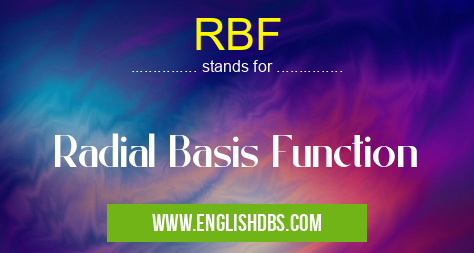What does RBF mean in STATISTICS
RBF (Radial Basis Function) is a type of function that takes the distance between two points as input and produces a value as output. They are often used in machine learning and scientific computing. RBFs are also known as kernel functions, basis functions, or interpolation functions.

RBF meaning in Statistics in Academic & Science
RBF mostly used in an acronym Statistics in Category Academic & Science that means Radial Basis Function
Shorthand: RBF,
Full Form: Radial Basis Function
For more information of "Radial Basis Function", see the section below.
Properties of RBFs
- Radial symmetry: The value of an RBF depends only on the distance between the two input points.
- Non-linearity: RBFs are typically non-linear functions.
- Smoothness: RBFs are usually smooth functions, meaning that they have continuous derivatives.
Common types of RBFs
There are many different types of RBFs, but some of the most common include:
- Gaussian RBF: This is the most popular type of RBF. It is defined as:
φ(r) = exp(-r^2 / (2σ^2))where r is the distance between the two input points and σ is a parameter that controls the width of the function.
- Inverse multiquadric RBF: This RBF is defined as:
φ(r) = 1 / (c^2 + r^2)^(1/2)where c is a parameter that controls the shape of the function.
- Multiquadric RBF: This RBF is defined as:
φ(r) = √(c^2 + r^2)where c is a parameter that controls the shape of the function.
Applications of RBFs
RBFs are used in a wide variety of applications, including:
- Machine learning: RBFs are used in many machine learning algorithms, such as support vector machines and radial basis function networks.
- Scientific computing: RBFs are used in a variety of scientific computing applications, such as interpolation, approximation, and solving partial differential equations.
Essential Questions and Answers on Radial Basis Function in "SCIENCE»STATISTICS"
What is a Radial Basis Function (RBF)?
An RBF is a mathematical function that maps a set of input points to a single output value. It is defined as a radial function of the distance between the input point and a set of predefined centers.
What are the advantages of using RBFs?
RBFs offer several advantages, including:
- Easy interpolation and approximation: RBFs can interpolate scattered data points smoothly, making them suitable for modeling complex surfaces.
- Flexibility: RBFs can approximate a wide range of functions due to their non-parametric nature.
- Local support: RBFs only influence the output value in a local neighborhood around the input point, making them computationally efficient.
What are the limitations of RBFs?
RBFs have some limitations as well:
- Computational cost: Training RBFs can be computationally expensive for large datasets.
- Overfitting: RBFs can easily overfit the data, leading to poor generalization performance.
- Sensitivity to noise: RBFs can be sensitive to noise in the input data, which can affect the accuracy of the approximation.
What are some applications of RBFs?
RBFs have found applications in various fields, including:
- Interpolation and approximation: Modeling surfaces, scattered data, and complex functions.
- Machine learning: Regression, classification, and clustering algorithms.
- Partial differential equations: Solving boundary value problems and differential equations.
- Computer graphics: Creating smooth transitions and blending surfaces.
How do you choose the appropriate RBF kernel?
The choice of RBF kernel depends on the specific application and data characteristics. Common kernels include:
- Gaussian: Smooth interpolation with good accuracy.
- Multiquadric: Captures local features and handles noise well.
- Inverse multiquadric: Suitable for scattered data with varying densities.
- Polyharmonic spline: Provides higher-order smoothness.
Final Words: RBFs are a powerful tool for a variety of applications. They are relatively easy to understand and use, and they can be used to solve a wide range of problems.
RBF also stands for: |
|
| All stands for RBF |
